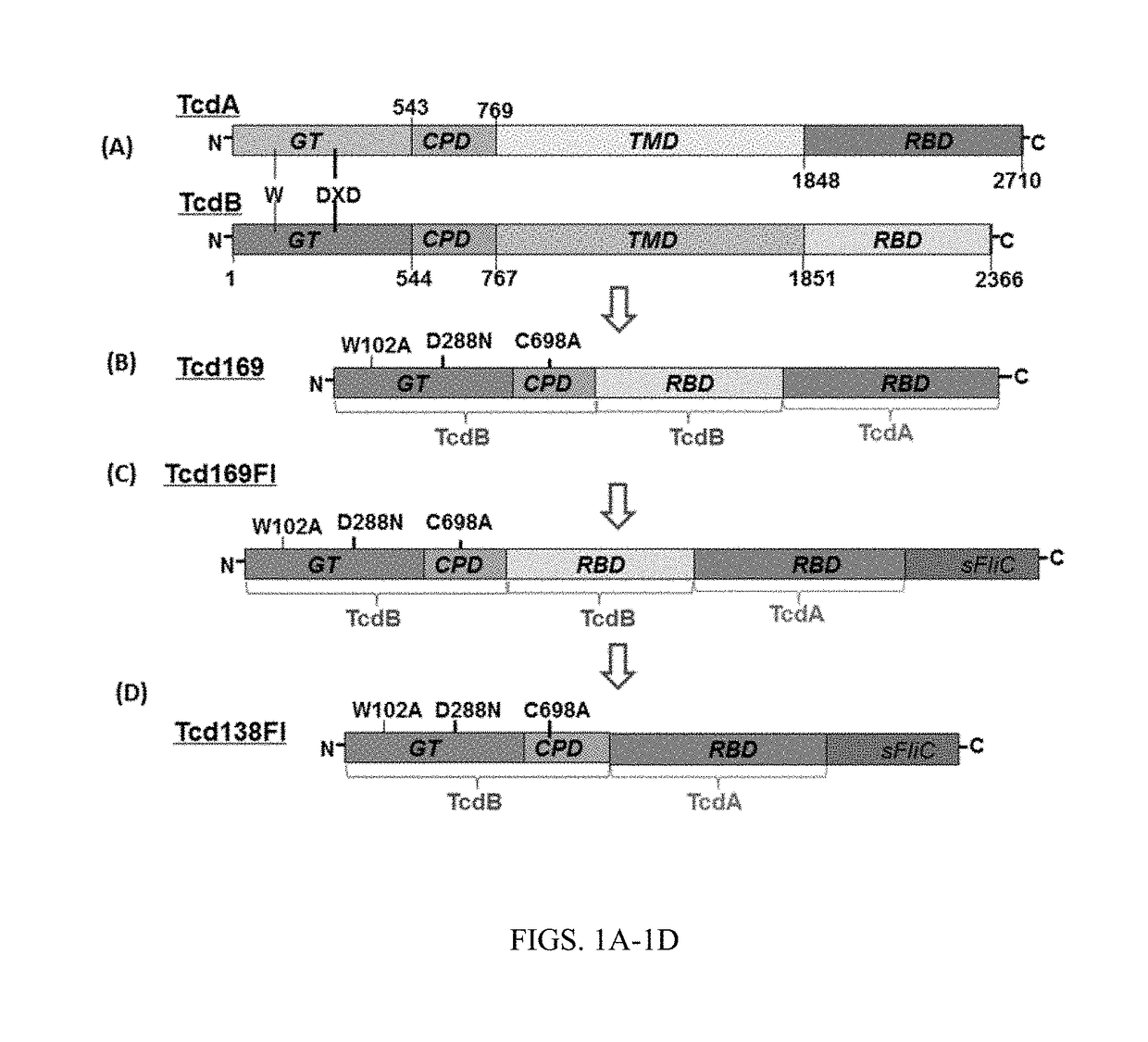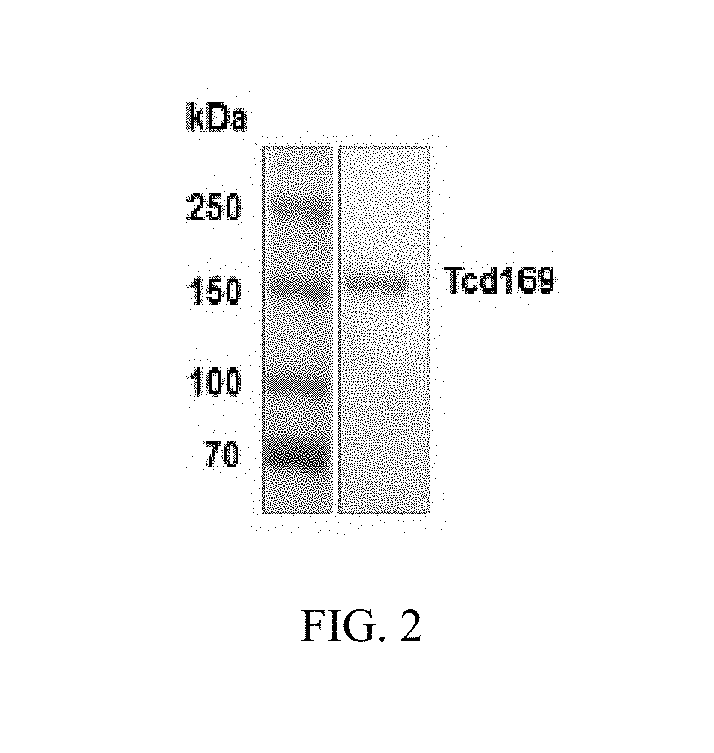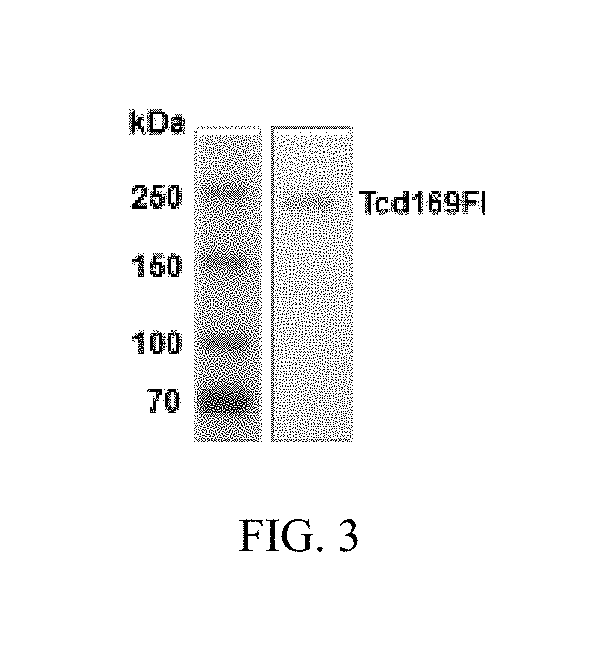Immunogenic proteins against clostridium difficile
a technology of immunogenic proteins and clostridium difficile, which is applied in the field of immunogenic proteins, can solve the problems of difficult antibiotic treatment of i>clostridium difficile/i>infections
- Summary
- Abstract
- Description
- Claims
- Application Information
AI Technical Summary
Benefits of technology
Problems solved by technology
Method used
Image
Examples
example 1
ion of Recombinant Fusion Proteins
[0118]As shown in FIG. 1A, TcdA and TcdB share similar domains, including the glucosyltransferase domain (GT), the cysteine proteinase domain (CPD), the transmembrane domain (TMD) and the receptor binding domain (RBD). The DXD motif and a conserved tryptophan in the GT are involved in the enzymatic activity. FIG. 1B shows the construction of Tcd169. Tcd169 was constructed by fusing the GT, CPD, and RBD of TcdB with the RBD of TcdA. The GT and CPD of TcdB are connected without a GGSG linker. The CPD of TcdB is connected to the RBD of TcdB by a GGSG linker (SEQ ID NO: 1), and the RBD of TcdB is connected to the TBD of TcdA by a GGSG linker (SEQ ID NO: 1). Tcd169 lacks a transmembrane domain. Two point mutations, W102A and D288N, were made in the GT of TcdB, and a C689A point mutation was made in the CPD of TcdB. FIG. 1C shows the construction of Tcd169F1. Tcd169F1 was made by fusing sFliC to Tcd169 with a GGSG linker (SEQ ID NO:1). As such, Tcd169F1 a...
example 6
Antibody Responses and Protection Against Systemic Toxin Challenge in Mice Immunized Intramuscularly with Tcd169F1 or Tcd169F1 and Cwp84 (“Tcd169F1 / Cw”)
[0126]Groups of C57BL / 6 mice (n=10) aged 6 weeks may be immunized IM with 10 μg of Tcd169F1 or Tcd169F1 and Cwp84 (“Tcd169F1 / Cw”) (10 μg each). Alum may be used as adjuvant for IM immunization. Sera and feces may be collected after each immunization and the anti-toxin, anti-sFliC or anti-Cwp IgA and IgG measured by ELISA.
example 7
Protection Against Systemic Toxin Challenge
[0127]A potent antibody response may be generated, that protects mice against challenge with a lethal dose of TcdA / TcdB (100 ng for each toxin). One week after the third immunization, mice may be challenged IP with a lethal dose of TcdA, TcdB or a mixture of TcdA and TcdB (100 ng for each toxin), and monitored for 72 hrs. If the protection is not optimal, dose optimization experiments may be performed.
PUM
| Property | Measurement | Unit |
|---|---|---|
| Immunogenicity | aaaaa | aaaaa |
Abstract
Description
Claims
Application Information
 Login to View More
Login to View More - R&D
- Intellectual Property
- Life Sciences
- Materials
- Tech Scout
- Unparalleled Data Quality
- Higher Quality Content
- 60% Fewer Hallucinations
Browse by: Latest US Patents, China's latest patents, Technical Efficacy Thesaurus, Application Domain, Technology Topic, Popular Technical Reports.
© 2025 PatSnap. All rights reserved.Legal|Privacy policy|Modern Slavery Act Transparency Statement|Sitemap|About US| Contact US: help@patsnap.com



